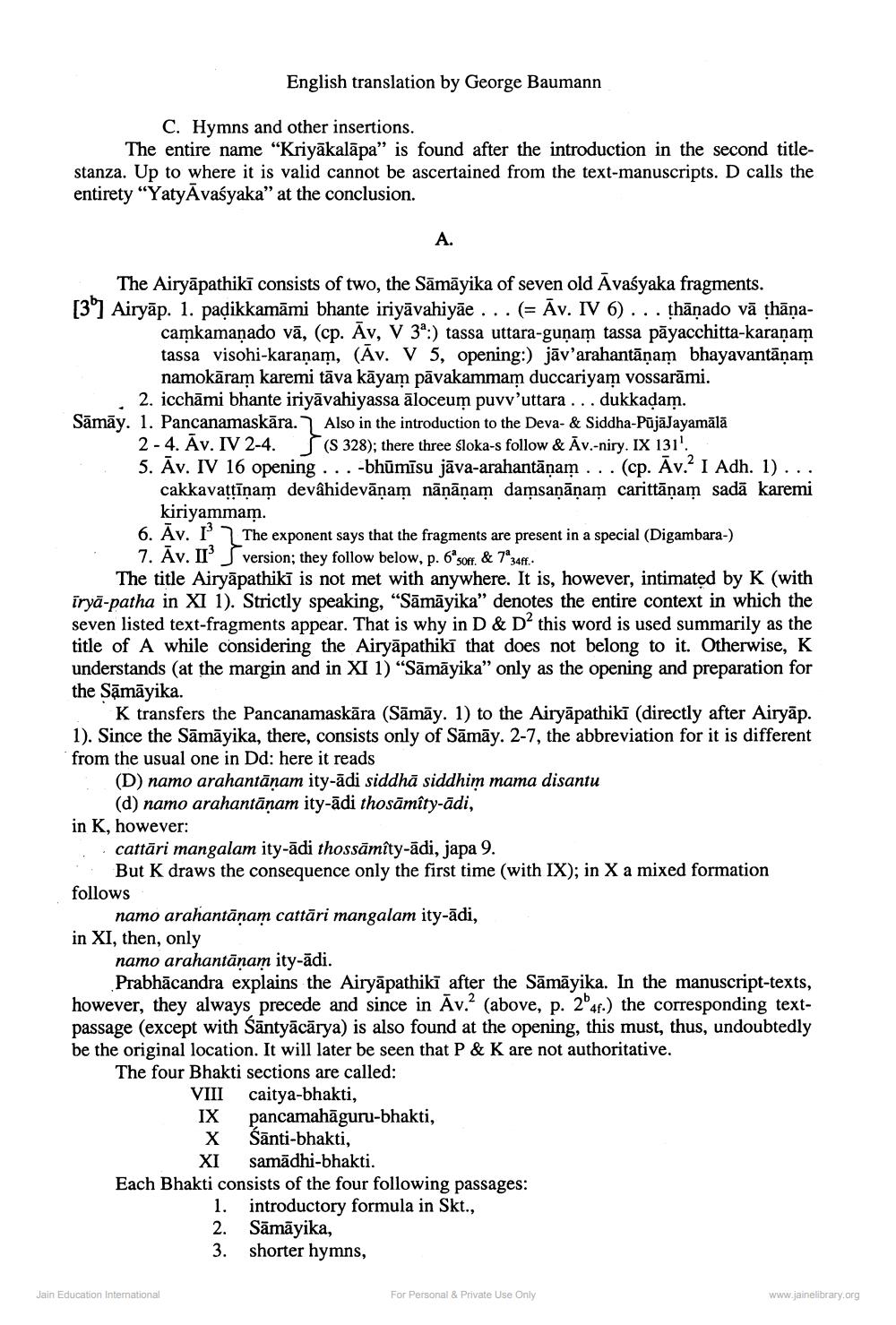________________
English translation by George Baumann
C. Hymns and other insertions.
The entire name “Kriyākalāpa" is found after the introduction in the second titlestanza. Up to where it is valid cannot be ascertained from the text-manuscripts. D calls the entirety "YatyAvasyaka" at the conclusion.
The Airyāpathiki consists of two, the Sāmāyika of seven old Avaśyaka fragments. [3] Airyāp. 1. padikkamāmi bhante iriyāvahiyae ... (= Āv. IV 6)... thānado vā
camkamanado vā, (cp. Āv, V 3a:) tassa uttara-gunam tassa pāyacchitta-karanam tassa visohi-karaṇam, (Av. V 5, opening:) jāv'arahantānam bhayavantānam
namokāram karemi tāva kāyam pāvakammam duccariyam vossarāmi.
2. icchāmi bhante iriyāvahiyassa āloceum puvv'uttara ... dukkadam. Sāmāy. 1. Pancanamaskāra. Also in the introduction to the Deva- & Siddha-PūjāJayamālā
2-4. Āv. IV 2-4. 5 (s 328); there three sloka-s follow & Āv.-niry. IX 131'. 5. Av. IV 16 opening ... -bhūmīsu jāva-arahantānam ... (cp. Av. I Adh. 1)...
cakkavattīņam devâhidevāņam nāņāņam damsaņāņam carittāņam sadā karemi
kiriyammam. 6. Av. I The exponent says that the fragments are present in a special (Digambara-)
7. Āv. Il version; they follow below, p. 6 soff. & 7o34ff.
The title Airyāpathikī is not met with anywhere. It is, however, intimated by K (with īryā-patha in XI 1). Strictly speaking, "Sāmāyika" denotes the entire context in which the seven listed text-fragments appear. That is why in D & D this word is used summarily as the title of A while considering the Airyāpathikī that does not belong to it. Otherwise, K understands (at the margin and in XI 1) "Sāmāyika" only as the opening and preparation for the Sāmāyika.
K transfers the Pancanamaskāra (Sāmāy. 1) to the Airyāpathiki (directly after Airyāp. 1). Since the Sāmāyika, there, consists only of Sāmāy. 2-7, the abbreviation for it is different from the usual one in Dd: here it reads
(D) namo arahantāņam ity-ādi siddhā siddhim mama disantu
(d) namo arahantānam ity-ādi thosāmîty-ādi, in K, however:
cattāri mangalam ity-ādi thossāmîty-ādi, japa 9.
But K draws the consequence only the first time (with IX); in X a mixed formation follows
namo arahantānam cattāri mangalam ity-ādi, in XI, then, only
namo arahantānam ity-ādi.
Prabhācandra explains the Airyāpathikī after the Sāmāyika. In the manuscript-texts, however, they always precede and since in Av. (above, p. 204f.) the corresponding textpassage (except with Śāntyācārya) is also found at the opening, this must, thus, undoubtedly be the original location. It will later be seen that P & K are not authoritative. The four Bhakti sections are called:
VIII caitya-bhakti, IX pancamahāguru-bhakti,
X Santi-bhakti,
XI samādhi-bhakti. Each Bhakti consists of the four following passages:
1. introductory formula in Skt., 2. Sāmāyika, 3. shorter hymns,
Jain Education International
For Personal & Private Use Only
www.jainelibrary.org




